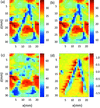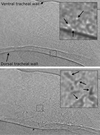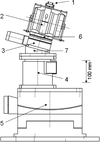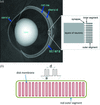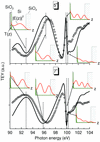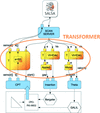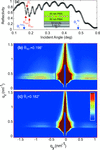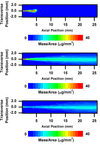issue contents
July 2012 issue

Cover illustration: Energy-dispersive X-ray diffraction computed tomography: reconstructing two-dimensional slices from sinograms on a channel-by-channel basis in the energy domain (see Lazzari, Egan, Jacques, Sochi, Di Michiel, Cernik and Barnes, pages 471-477).
facility information
research papers
A new data collection strategy for performing synchrotron energy-dispersive X-ray diffraction computed tomography has been devised which overcomes previous limitations of such methods, in particular spatial resolution.
The association of microbeam radiation therapy with chemotherapeutic agent JAI-51 has been evaluated for the treatment of 9LGS implanted in rat brains, particularly the effects on the median survival time of the rats. The effects of both treatments, alone or combined, on the tumor cell cycle ex vivo have been characterized.
An image analysis method employing optical flow computations is proposed to localize and quantify coalescence events in series of projection images. The method was successfully tested for the study of aqueous, metal and polymer foams observed by X-ray radiography.
It will be shown that the bandpass obtainable by using arrays of prisms in an X-ray monochromator operated with an exit slit can be easily predicted analytically. Some improved monochromator designs will be presented.
A new method for measurement of short excited-state lifetimes of photoactive species in crystals is described. Based on photocrystallographic techniques, the method is an alternative to emission-lifetime measurement and is also applicable to non-luminescent species. It has potential for the determination of structures of very short-lived species.
The local structures of pure NiAl and Ti-, Co-doped NiAl compounds have been obtained utilizing extended X-ray absorption fine-structure spectroscopy.
The concept and performances of the DESIRS undulator-based VUV beamline at SOLEIL are presented, showing that DESIRS is establishing the state-of-the-art in terms of spectral resolution, spectral purity, flux and well calibrated variable polarizations.
Synchrotron microanalytical techniques such as X-ray fluorescence, X-ray beam induced current and X-ray excited optical luminescence are applied to two potential photovoltaic-related semiconductors: multicrystalline Si and single-crystal GaAs.
Dose-compatible measurements of a mammography phantom demonstrate an increase in contrast attainable through differential phase and dark-field imaging over conventional absorption-based projections. All measurements have been performed at 21 keV using a monochromatic laser-driven miniature synchrotron X-ray source (Compact Light Source).
The evolution of the calcite–ethanol interface induced by synchrotron radiation is studied by X-ray reflectivity and X-ray photoelectron spectroscopy.
The first microbeam synchrotron radiation X-ray fluorescence beamline in Thailand is now available for archaeological application and others.
Open  access
access
 access
accessLocal structure studies about Cd in the Cd1–xCaxO solid solution through Cd K-edge EXAFS studies are described, indicating a bimodal distribution of the first nearest neighbour distance for Cd and that the optical properties should belong to a persistence type.
Interpretation of X-ray fluorescence images of archeological artifacts is complicated by the presence of surface relief and roughness. Using two symmetrically arranged fluorescence detectors in a back-reflection geometry, the proper X-ray fluorescence yield can be distinguished from intensity variations caused by surface topography. This technique has been applied to the study of Roman inscriptions on marble.
Synchrotron phase-contrast X-ray imaging was used to non-invasively examine the mucociliary transit behaviour of different particles after dry deposition into the trachea of live mice. The post-deposition behaviour of individual particles of the respiratory pollutants quarry dust, fibreglass and lead sulfide, together with reference hollow silver-coated glass beads, was examined and compared with our previous studies where the same particles were delivered within a saline carrier fluid.
A detailed description of the energy-domain Synchrotron Mössbauer Source at the ESRF is given and application examples are presented.
A time-dependent photoelectron spectroscopy study of the chemical reactions which take place at Pt(111) surfaces is presented. It is shown that the carbon contamination layer growth can be stopped and reversed by low partial pressures of oxygen for optics operated in intense photon beams at liquid-nitrogen temperature.
Open  access
access
 access
accessX-ray diffraction was recorded from retinal rod outer segments of frog using a microbeam.
Partial least-square (PLS) regression was used to evaluate mixtures of Cd L3-edge spectra of references compounds and the obtained PLS model was then applied to a soil sample in order to qualify and quantify the Cd species therein.
Synchrotron radiation has been used to test the resistance to hard X-rays of hybrid organic–inorganic films doped with increasing amounts of fullerene C60.
Structural properties of CdWO4 investigated by EXAFS and the role of Cd and W atoms on the XEOL mechanism of CdWO4 are described.
A description of a compact spectrometer for FLASH at DESY is presented, including the design and commissioning results.
Open  access
access
 access
accessA sample-independent method is presented to calibrate an X-ray energy scale of a high-energy-resolution monochromator with sub-meV relative accuracy by using the detailed-balance principle.
The general matrix theory of the photoelectron/fluorescence excitation in anisotropic multilayer films at the total reflection condition of X-rays has been developed. The observed distortions in the total electron yield Si L2,3 spectra measured using synchrotron radiation from a SiO2/Si/SiO2/c-Si sample at different glancing angles of incidence have been explained by the creation of waveguide modes in the middle Si layer.
The synchronous undulator–monochromator scans (SUMS) strategy developed at Synchrotron Soleil for performing X-ray absorption experiments at insertion-device beamlines is described.
The design, commissioning, unique capabilities and recent results from the dedicated grazing-incidence X-ray scattering beamline 8-ID-E at the Advanced Photon Source are described.
A spot-integration method is described which does not require prior indexing of the reflections. It is based on statistical analysis of the values from each of the pixels on successive frames, followed for each frame by morphological analysis of initial masks to identify appropriate reflection footprints. The results are compared with those of the seed-skewness method which is based on minimizing the skewness of the intensity distribution within a peak's integration box.
beamlines
Open  access
access
 access
accessThe MiNaXS (P03) beamline of the new third-generation synchrotron radiation source PETRA III (DESY, Germany) has been designed to perform small-, ultra-small- and wide-angle X-ray scattering in both transmission and grazing-incidence geometries. The high photon flux available at the beamline enables time-resolved investigations of kinetic phenomena with a time resolution below 100 ms. The microfocus endstation started user operation in May 2011.
Open  access
access
 access
accessThe 7BM beamline, a facility for time-resolved fluid dynamics measurements at the Advanced Photon Source, is described.
current events
Free 



 journal menu
journal menu
































